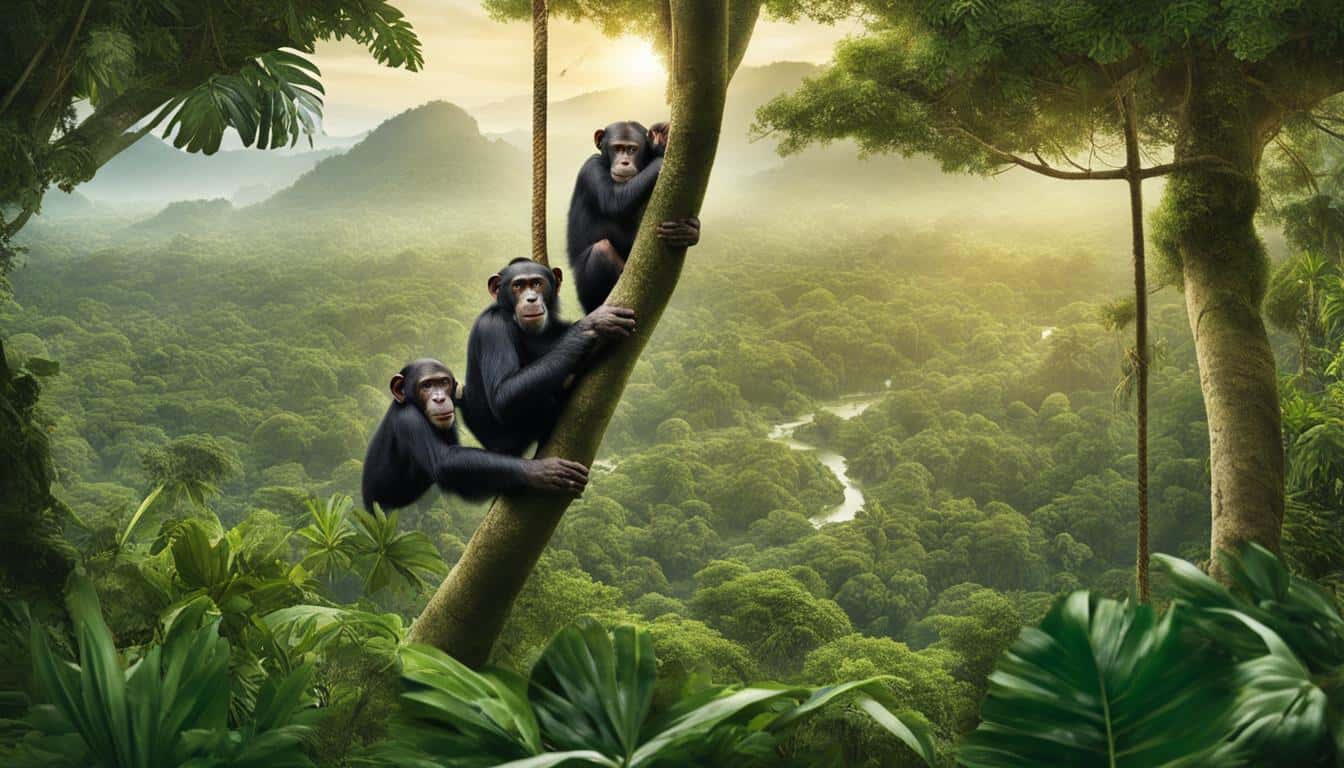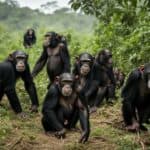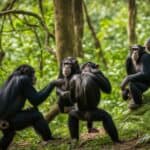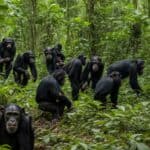Chimpanzees, our closest living relatives in the animal kingdom, have faced numerous threats to their survival, including habitat destruction, excessive hunting, and disease transmission. However, there have been remarkable success stories in chimpanzee conservation efforts that offer hope for the future.
Effective chimpanzee conservation efforts have been implemented worldwide, focusing on protecting the species and improving their population status. One notable initiative is the AZA SAFE: Saving Animals From Extinction chimpanzee program, which was established in 2019. It aims to promote collaborative conservation action and raise public awareness to safeguard all four chimpanzee subspecies.
In our upcoming article, we will explore successful cases of chimpanzee conservation that highlight the impact of these efforts. We will delve into the major threats faced by chimpanzees, including hunting, habitat loss, and disease transmission. Additionally, we will discuss collaborative conservation efforts facilitated by AZA-accredited facilities and government agencies to support the recovery of chimpanzee populations.
Stay tuned to discover notable conservation success stories, such as the Ngogo Chimpanzee Project, the Goualougo Triangle Ape Project, and the Tonkolili Chimpanzee Project. These initiatives demonstrate how small-scale conservation efforts can achieve significant outcomes for chimpanzee conservation.
Moreover, we will provide actionable steps that individuals can take to help protect chimpanzees in the wild. From choosing Forest Stewardship Council certified products to donating to the SAFE chimpanzee program, each action can make a meaningful difference in conserving these incredible creatures and their habitats.
Major Threats to Chimpanzees
Chimpanzees face three significant threats: hunting, habitat loss, and disease transmission. The encroachment of human activities leads to habitat loss, increasing the instances of conflict between humans and chimpanzees. This often results in retaliatory hunting or targeted poaching for meat. Disease transmission is also a major concern, as chimpanzees are susceptible to many of the same diseases as humans. The increased overlap between chimpanzees and humans raises the risk of disease transmission, making it crucial to address these threats collectively.
| Threat | Description |
|---|---|
| Hunting | Retaliatory hunting and targeted poaching for meat |
| Habitat Loss | Human activities leading to habitat destruction |
| Disease Transmission | Increased overlap with humans leading to the spread of diseases |
Collaborative Conservation Efforts
AZA-accredited facilities have joined forces with government agencies in a collaborative effort to contribute to the recovery of chimpanzee populations. Their combined efforts have led to significant milestones in chimpanzee conservation, including the full protection of chimpanzees in captivity.
One notable achievement was the reclassification of all chimpanzees as endangered under the Endangered Species Act in 2015. This critical change marked the end of private chimpanzee ownership and exploitation by the media entertainment industry, ensuring greater protection for these incredible creatures.
The collaboration between AZA-accredited facilities and animal conservation organizations was instrumental in this achievement. Through joint advocacy efforts, they successfully petitioned the U.S. Fish and Wildlife Service to address the disparity in the listing of chimpanzees, resulting in comprehensive protection measures.

This triumph represents an unprecedented win for great apes in the United States and highlights the power of collaborative conservation efforts.
| Collaboration Impact | AZA-accredited facilities | Government agencies |
|---|---|---|
| Chimpanzee Status | Active involvement in advocating for endangered status | Policy implementation and enforcement |
| Habitat Conservation | Support for habitat restoration and protection initiatives | Land management and conservation planning |
| Research and Monitoring | Contributions to scientific studies and field research | Data collection and analysis for evidence-based conservation |
| Public Awareness | Communication and education campaigns | Outreach programs to promote conservation efforts |
These collaborative efforts between AZA-accredited facilities and government agencies play a crucial role in the recovery and future well-being of chimpanzee populations, ensuring a brighter future for these magnificent creatures.
Notable Conservation Success Stories
The AZA SAFE: Saving Animals From Extinction chimpanzee program has various field partners with remarkable conservation success stories. These initiatives demonstrate the positive impact of small-scale efforts in achieving significant outcomes for chimpanzee conservation.
Ngogo Chimpanzee Project
The Ngogo Chimpanzee Project, operating within Kibale National Park, has made notable progress in dismantling illegally set snare traps. This proactive approach has led to a reduction in injuries caused by these snares, improving the overall well-being and survival of the chimpanzees in the area.
Goualougo Triangle Ape Project
The Goualougo Triangle Ape Project focuses on sustainable logging practices, promoting the science of resource extraction that minimizes the impact on chimpanzee habitats. Through their dedicated efforts, this project contributes to preserving the delicate balance between human needs and the conservation of ape populations.
Tonkolili Chimpanzee Project
The Tonkolili Chimpanzee Project in Sierra Leone has successfully implemented a moratorium on chimpanzee killing in the area through partnerships with local communities and the introduction of alternative income sources. By engaging with the community and providing viable alternatives, the project has fostered coexistence between humans and chimpanzees, ensuring the long-term survival of these remarkable creatures.
Actions to Help Chimpanzees
As individuals, you can make a difference in protecting chimpanzees and their natural habitats in the wild. By taking the following actions, you can contribute to the conservation efforts:
- Choose Forest Stewardship Council (FSC) certified products: When purchasing paper and wood products, look for the Forest Stewardship Council (FSC) certification. FSC certified products come from responsibly managed forests, ensuring sustainable logging practices. By opting for certified products, you not only support sustainable industries but also help protect chimpanzee habitats. Together, we can preserve the homes of these incredible creatures.
- Donate to the SAFE chimpanzee program: Your generous donations can directly support the conservation efforts carried out by the AZA-accredited facilities through the SAFE chimpanzee program. These funds enable the implementation of various conservation initiatives, such as preserving chimpanzee habitats, promoting public awareness, and supporting research projects. By donating to the SAFE chimpanzee program, you contribute to the long-term survival of chimpanzee populations and the protection of their natural habitats.
Together, we can help safeguard the future of chimpanzees by promoting sustainable practices and supporting dedicated conservation organizations. Your actions today can make a significant impact on the well-being of these remarkable creatures for generations to come.
Evaluating the Effectiveness of Offset Projects
A study conducted by the IUCN SSC Primate Specialist Group and Re:wild found that even the most ambitious private sector offset projects may not be sufficient to effectively protect great apes, including chimpanzees. The study focused on the Moyen Bafing National Park in Guinea, a critical habitat for these endangered species.
The report highlights the need for long-term protection of offset areas and provides recommendations to strengthen offset projects to achieve a true “net gain” for great apes. One of the key challenges is mitigating potential threats such as large dams that could harm chimpanzee populations. By implementing adequate measures, offset projects can help ensure the survival and conservation of these remarkable creatures.
Summary of Recommendations for Effective offset projects in Moyen Bafing National Park
| Recommendations | Description |
|---|---|
| 1 | Implement comprehensive surveillance and anti-poaching measures to safeguard great ape populations. |
| 2 | Establish strict regulations to protect habitats from large-scale infrastructure projects that pose a threat to chimpanzees. |
| 3 | Collaborate with local communities to promote sustainable livelihoods and reduce human-wildlife conflicts. |
| 4 | Create educational programs to raise awareness about the importance of great ape conservation and foster a sense of responsibility among local stakeholders. |
| 5 | Support research efforts to better understand the behavior and ecology of great apes, enabling more informed conservation strategies. |
Challenges in Chimpanzee Conservation
Chimpanzee conservation faces several challenges that threaten their population and well-being. The main challenges include poaching, habitat loss, and human-wildlife conflict. Each of these factors contributes to the decline of chimpanzee populations and requires urgent attention.
Poaching: Poaching for meat and body parts remains a significant threat to chimpanzees. The demand for bushmeat and the illegal wildlife trade drive the hunting of chimpanzees, resulting in a decline in their numbers. This illegal activity not only reduces their population but also disrupts their social structures and ecological balance.
Habitat Loss: Habitat loss is another major challenge in chimpanzee conservation. The clearing of forests for agriculture, logging, and infrastructure development destroys chimpanzee habitats. Additionally, climate change exacerbates the problem by altering the availability of resources and disrupting the delicate balance of ecosystems where chimpanzees reside.
Human-Wildlife Conflict: As human populations expand and encroach upon chimpanzee habitats, conflicts arise. Chimpanzees enter agricultural fields in search of food, leading to crop damage and economic losses for local communities. In response, farmers may resort to retaliatory actions that harm chimpanzees, further intensifying the conflict.
Addressing these challenges requires a comprehensive approach that considers all aspects of conservation. Efforts should focus on strengthening anti-poaching measures, protecting and restoring chimpanzee habitats, and promoting sustainable practices that reduce human-wildlife conflict. Collaborative efforts involving local communities, government agencies, and conservation organizations are essential for implementing effective strategies and securing a better future for chimpanzees.
The Role of Long-term Primate Research
Long-term primate research programs, such as the Kibale Chimpanzee Project, play a vital role in the protection of endangered primate species and their habitats. The Kibale Chimpanzee Project has been studying the Kanyawara community of wild chimpanzees since 1987, providing valuable insights into their behavior, ecology, and physiology.
This long-term primate research has significantly contributed to conservation efforts by informing and fostering both local and international conservation programs. The extensive knowledge gained through years of observation and data collection has helped in the formulation and implementation of effective conservation strategies.
Moreover, the research carried out by the Kibale Chimpanzee Project has played a crucial role in catalyzing habitat protection and leading to positive economic impacts in the Kibale community. By understanding the complex interactions between chimpanzees, their ecosystem, and local human populations, this research has facilitated the development of sustainable solutions that benefit both wildlife and communities.
In addition, the Kibale Chimpanzee Project has actively engaged in conservation education programs, raising awareness and promoting a sense of stewardship among local residents and visitors. By fostering an understanding of the importance of primate conservation, the project has inspired individuals to take action in preserving these remarkable species and their habitats for future generations.
What Conservation Efforts Have Led to Successful Chimpanzee Population Growth?
The conservation status of chimpanzee populations has seen positive growth due to efforts such as protected habitat areas, anti-poaching measures, and community education. These interventions have helped in stabilizing and even increasing chimpanzee numbers in certain regions, offering hope for the species’ long-term survival.
Are There Specific Conservation Efforts That Have Led to Successful Cases of Chimpanzee Conservation?
Yes, there have been specific conservation efforts that have led to successful cases of chimpanzee population conservation status. By implementing measures such as protected areas, anti-poaching patrols, community education, and habitat restoration, organizations have been able to make significant strides in improving the chimpanzee population conservation status in various locations.
Source Links
- https://www.iucn.org/news/species-survival-commission/202110/new-report-highlights-challenges-and-opportunities-offsetting-private-sector-damage-western-chimpanzee-habitat-west-africa
- https://www.ncbi.nlm.nih.gov/pmc/articles/PMC7709955/
- https://www.aza.org/connect-stories/stories/celebrating-50-years-of-the-endangered-species-act-chimpanzees







